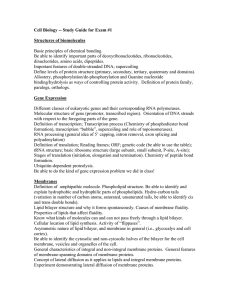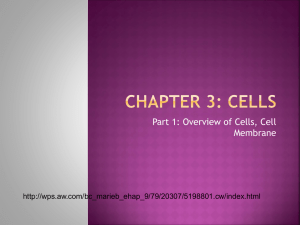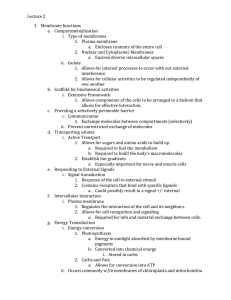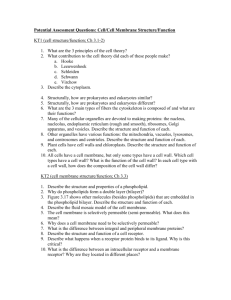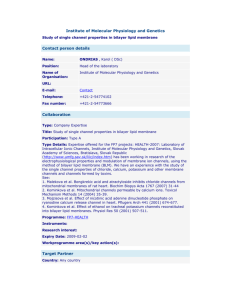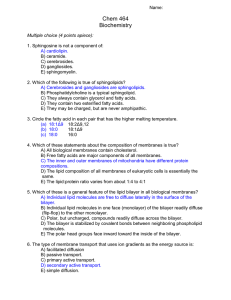Name: Chem 464 Biochemistry Third Hour Exam
advertisement
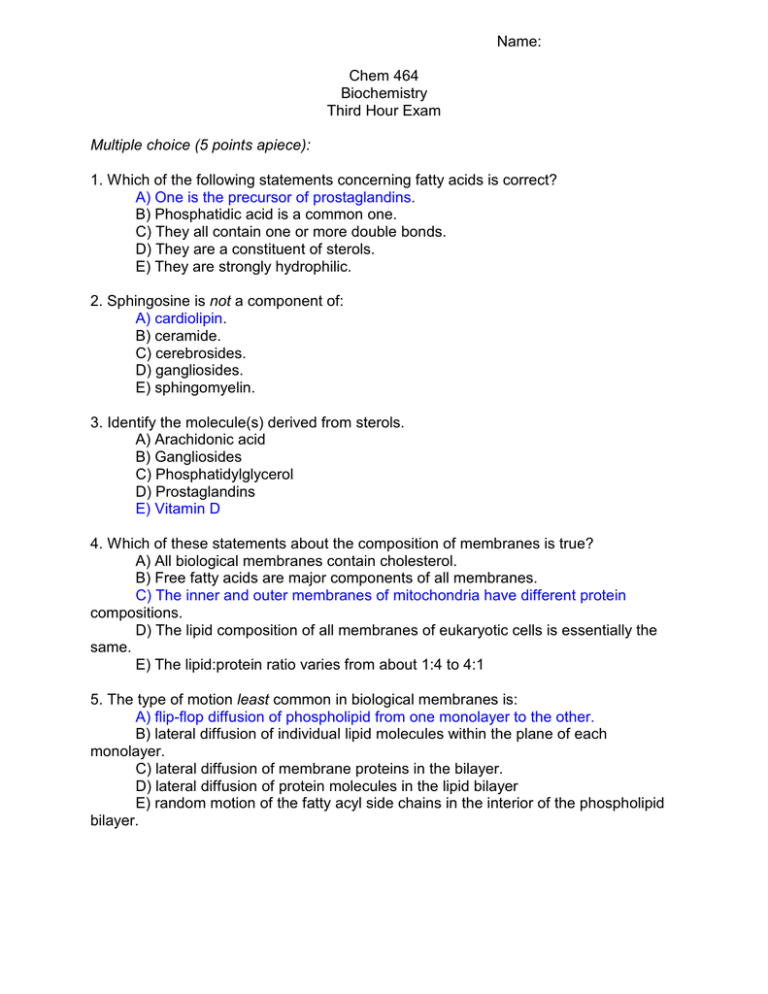
Name: Chem 464 Biochemistry Third Hour Exam Multiple choice (5 points apiece): 1. Which of the following statements concerning fatty acids is correct? A) One is the precursor of prostaglandins. B) Phosphatidic acid is a common one. C) They all contain one or more double bonds. D) They are a constituent of sterols. E) They are strongly hydrophilic. 2. Sphingosine is not a component of: A) cardiolipin. B) ceramide. C) cerebrosides. D) gangliosides. E) sphingomyelin. 3. Identify the molecule(s) derived from sterols. A) Arachidonic acid B) Gangliosides C) Phosphatidylglycerol D) Prostaglandins E) Vitamin D 4. Which of these statements about the composition of membranes is true? A) All biological membranes contain cholesterol. B) Free fatty acids are major components of all membranes. C) The inner and outer membranes of mitochondria have different protein compositions. D) The lipid composition of all membranes of eukaryotic cells is essentially the same. E) The lipid:protein ratio varies from about 1:4 to 4:1 5. The type of motion least common in biological membranes is: A) flip-flop diffusion of phospholipid from one monolayer to the other. B) lateral diffusion of individual lipid molecules within the plane of each monolayer. C) lateral diffusion of membrane proteins in the bilayer. D) lateral diffusion of protein molecules in the lipid bilayer E) random motion of the fatty acyl side chains in the interior of the phospholipid bilayer. 6. Which of these statements about facilitated diffusion across a membrane is true? A) A specific membrane protein lowers the activation energy for movement of the solute through the membrane. B) It can increase the size of a transmembrane concentration gradient of the diffusing solute. C) It is impeded by the solubility of the transported solute in the nonpolar interior of the lipid bilayer. D) It is responsible for the transport of gases such as O2, N2, and CH4 across biological membranes. E) The rate is not saturable by the transported substrate Longer questions (10 points each) 7. Draw the structure of a fatty acid designated 20:3(Ä5,8,11) 8. One of the lipids that was difficult to place in our lipid structural organization was Sphingomyelin. Describe the structure of sphinomyelin and tell why this structure has characteristics of a couple of different membrane lipids. Sphingomyelin has a sphingosine backbone with a fatty acid attached by an amide linkage and either a phosphocholine or a phosphoethanolamine charged polar head group. The phosphocholine or phosphoethanolamine makes this a phospholipid. Yet most of the sphingolipids have sugars as the charged head group, so there is a tendency to want to put this in the class of glycolipids. 9. Define the following terms F-type ATPase While it is classed as an ATPase because it will hydrolyze ATP to pump protons across a membrane, the actual activity of this enzyme in a cell is to allow protons to come into a cell or organelle down a gradient, and synthezie ATP from ADP and Pi symport A transport mechanism where 2 different molecules are transported by the same enzyme either into or out of the cell at the same time. Aquaporin A pore protein that is used to allow water molecules to enter or leave the cell. Bilayer The lipid membrane around a cell or organelle. It is called a bilayer because it is composed of two layers of membrane lipids. ionophore A molecule that wraps itself around an ion to give it a hydrophobic exterior that allows the ion-ionophore complex to easily cross the lipid bilayer. 10. Describe how K+ Channel works The protein furnishes a passage through the membrane that is just big enough for a non-hydrated K+ ions to pass. The carbonyl groups of the polypeptide backbone lining this passage provide the ion with enough polar interactions to replace the interactions the ion usually has with its hydrating water molecules. A non-hydrated Na+ ion is too small to properly interact with these carbonyl groups, so it doesn’t pass, and a hydrated Na+ ion is too large to enter the channel. The protein also has several negatively charged residues at both ends of the pore to repel any negative ions that might try to pass and, presumably, to attract positively charged K+ ions to the protein to find the pore. 11. What is the difference between a G protein coupled receptor signal system and a receptor guanylyl cyclase receptor signal system? In a G protein coupled receptor the primary message binds to a specific receptor protein on the cell membrane. This protein then displaces a GDP from a stimulatory G protein and it is replaced with a GTP. The stimulatory G protein then activates a second membrane bound protein to create a second messenger inside the cell, often cAMP. In a guanylyl cyclase receptor system when the primary message binds to the receptor protein, the receptor protein itself converts GTP to the second messenger cGMP. 12. Next semester we will examine the enzyme that converts fructose 6-phosphate to glucose 6- phosphate. A. If this reaction has an equilibrium constant of 1.97 at 25o C, what is the ÄG o’ for this reaction? ÄGo’ = -RTlnK’ = -8.314(298)ln(1.97) = -2477(.678) = -1680 Joule = -1.68 kJ B. What is the ÄG for this reaction if the concentration of fructose 6-phosphate is adjusted to 1.5M and the concentration of glucose 6-phosphate is adjusted to .1M? ÄG=ÄGo’ -RTlnQ = -1680 +8.314(298)ln(0.1/1.5) = -1680 + 2477(-2.71) = -1680 + -6710 = -8390 J = -8.39 kJ 13. In class we discussed three different compounds that contain phosphate groups with a higher energy than the phosphate group in ATP. What were these three high energy compounds and what is it about their structure that make them high energy compounds? Phosphoenol pyruvate (PEP) converted to pyruvate and a phosphate group. The enol intermediate that is obtained when the phosphate is removed is very high energy because it needs to convert to the lower energy keto form. The conversion of the high energy phosphoenol to the low energy ketone is what drives this reaction. The products are also favored because negative charges in the PEP have been separated and a single reactant has been split into two products 1,3-Bisphosphoglycerate converted to phosphoglycerate and a phosphate group The mixed phospho-carboxyl anhydride releases lots of energy when is it cleaved because the resulting free carboxylic acid is resonance stabilized so it has a much lower energy. The products are also favored because 2 of negative charges in the phosphoglycerate have been separated and from the molecule a single reactant has been split into two products Phosphocreatine converted to creatine and a phosphate. Phosphocreatine is high energy when compared to the creatine product because the creatine product is very low energy due to the resoance stabilization of the product. Entropy also favors the separation of phosphocreatine into phophate and creatine. 1A 2A 3E 4 4C 5A 6A
